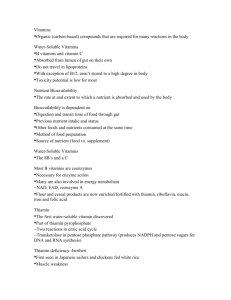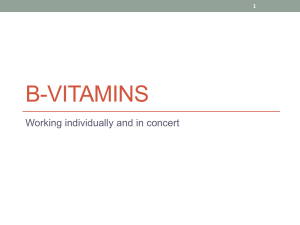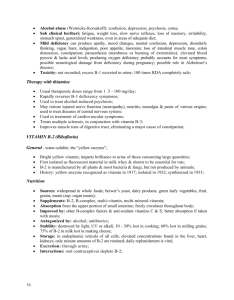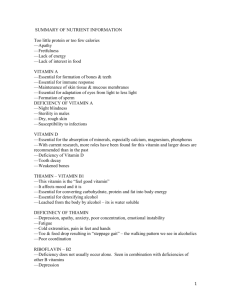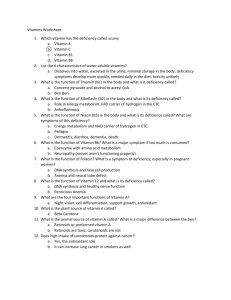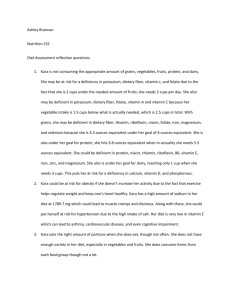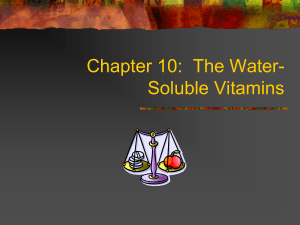10) water soluble vitamins
advertisement
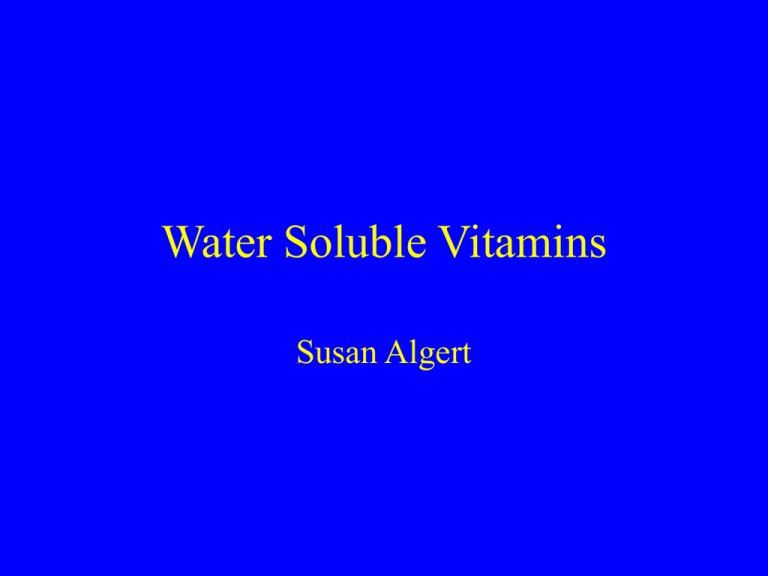
Water Soluble Vitamins Susan Algert Water Soluble Vitamins Thiamin Riboflavin Niacin Vitamin B-6 Folate Vitamin B-12 Pantothenic Acid Biotin Vitamin C Fat vs. Water Soluble Vitamins Water Soluble Fat Soluble Lymph via CM Transport Directly to blood free Storage Circulate freely In cells with fat Excretion In urine Stored with fat Toxicity Possible w supplements Requirements Every 2-3 days Likely w supplements Every week Absorption Require carrier Water soluble vitamins • Susceptible to heat • Kidney removes and excretes excess • Vitamin C, thiamin and riboflavin are especially susceptible to heat and alkilinity • Hydrophilic and water will leach them from vegetables • Preferred methods are steaming, stir-fry and microwave B vitamins act as co-enzymes Thiamin • Sulfur containing and nitrogen containing rings attached to carbon atoms • Part of nerve cell membranes—synthesize and regulate neurotransmitters • Functions in energy metabolism—vitamin portion of TPP; plays role in decarboxylation and helps form Acetyl Co A from pyruvate Thiamin • Dietary Recommendation RDA for adult men is 1.2 mg for women is 1.1 mg per day Higher needs in pregnancy; most diets with variety and adequate energy supply ample thiamin Thiamin • Deficiency • Heavy alcohol consumption with inadequate food consumption ; alcohol interferes with absorption (WernickeKorsakoff syndrome); poor and elderly at risk for not eating sufficient energy Thiamin Deficiency/Toxicities • Beri Beri • Impaired muscle contractions • Impaired cardiac function, edema and muscle twitches • Decreased neurological function and memory loss Thiamin food sources • • • • Pork Whole and enriched grains Fortified cereals Most animal foods contain little thiamin Riboflavin • Involved in energy metabolism; part of two co-enzymes, FMN and FAD • Participate in citric acid cycle and beta oxidation and electron transport • Remove ammonia during deamination of some amino acids • Associated with antioxidant glutathione peroxidase Dietary Recommendations for Riboflavin • RDA is 1.1 mg for women and 1.3 mg for men per day • Pregnancy and lactation increase energy needs and need for riboflavin Food Sources • Most plant and animal foods • Milk and milk drinks and yogurt supply about 15% in the American diet • Fortified cereals, bread and bread products contribute about 10% • One of four vitamins added to enriched products Deficiency/Toxicity • Deficiencies are rare although some people may take in marginal amounts • Drug and alcohol users and restricted caloric intake • Ariboflavinosis • Toxicity– not observed Niacin (Nicotinic Acid) • Made from tryptophan; essential nutrient if protein intake is inadequate • 60 mg tryptophan converts to 1 mg niacin • RDA is 14-16 NE/day for adults • NE include preformed and niacin derived from tryptophan Functions of Niacin • NAD and NADP play key role in oxidation-reduction reactions • Helps convert pyruvate to lactate • Coenzyme component that participates in over 200 metabolic reactions Food Sources • Preformed niacin from meat, poultry fish and enriched or whole grain products • Beef and processed meats are substantial contributors in U.S. diet • Stable when heated • Tryptophan found in protein rich animal foods Niacin deficiency • Pellagra • Epidemic in southwest in early 1900’s as corn became staple; niacin is bound by protein • Deficiencies found in southeast if subsisting on diet of corn, molasses and salt pork • International health issue Medicinal uses of niacin • • • • • • Lowers blood levels of LDL cholesterol Raises HDL cholesterol Doses of 1,300 mg to 3,000 mg per day Side effects include liver abnormalities UL for niacin is 35 mgms per day Taken only under medical supervision Biotin • Function critical in energy metabolism ; TCA cycle and gluconeogenesis • Bound to enzymes as a co-factor and requirement is small • No RDA; AI is 30 micrograms/day • Deficiency rare and toxicity not seen Pantothenic Acid • Component of Co enzyme A; involved in energy metabolism • No RDA; AI is 5 mg/day • Deficiency is rare (dermatitis, hair loss, depression) • Toxicity is rare Vitamin B-6 • Forms include pyridoxal, pyridoxine, and pyridoxamine and phosphorylated forms • Functions include support of over 100 different enzyme reactions including : transfer of amino group, carboxyl group or water Enzymes support protein metabolism, blood cell synthesis, CHO metabolism, neurotransmitter synthesis Dietary Recommendations and Sources • RDA is 1-3 mg/day; TUL =100 mg/day • Deficiency symptoms include weakness, insomnia, depression, irritability • Sources include fortified cereals, meat, fish, poultry, starchy vegetables and noncitrus fruits • Heat sensitive; most people get enough B6 Toxicity and Medicinal Use • Megadoses of up to 2,000 mg/day can cause irreversible nerve damage • Large doses used to treat PMS or in stress formulas • UL is 100 mg/day • High doses taken only under medical supervision Folate • Converts vitamin B-12 to coenzyme form • Supports DNA synthesis and cell replication and growth • Along with B12 and B6, may decrease risk for heart disease • Tetrahydrofolic acid (THFA) is coenzyme with five active forms Dietary Recommendations and Deficiency • RDA is 400ug/day (is it most prevalent vitamin deficiency?) • TUL is 1000 ug/day • Deficiency causes macrocytic anemia, NTD • Toxicity masks vitamin B12 deficiency • Dietary folate equivalents= higher bioavailability of supplemental folate vs. folate in foods Folate in foods • • • • • • • Fortified ready to eat cereals Dark green leafy vegetables Asparagus Broccoli Orange juice Wheat germ Legumes Vitamin B-12-Cyanocobalamin • Cobalamin or cobalt containing compounds • Transfers methyl group from folate coenzyme THFA to make active form; B12 deficiency leads to folate deficiency • Dietary recommendations 2.4 ugm/day for men and women • Atrophic gastritis decreases bioavailability in adults over 51 Vitamin B-12 Absorption • • • • • R-protein pancreatic enzymes Intrinsic factor Bacteria in the stomach Gastric acid production B12 in the diet • RDA is 2.4 ugm per day; B12 not present in plant foods • Animals store excess B12 in tissues • Mixed foods with animal protein contribute most B12 • B12 deficiency usually occurs due to impaired absorption • Vegans at risk Deficiency disease is pernicious anemia • Megaloblasts and macrocytes rather than normal red blood cells • Brain abnormalities and spinal cord degeneration which can be lethal • Pernicious anemia attacks parietal cells and diminishes intrinsic factor and stomach acid Functions of Vitamin C • Antioxidant—donates electron minimizing free radical damage; Recycles oxidized vitamin E for reuse • Collagen synthesis • Stabilizes reduced form of folate enzyme • Enhances absorption of non-heme iron • Helps synthesize carnitine • Proper functioning of immune system Vitamin C deficiency/toxicity • • • • • Scurvy Breakdown gums and joints Bone pain, diarrhea, fractures, fatigue UL is 2,000 mg per day Can possibly enhance oxidation when consumed in high doses without other antioxidants Dietary Recommendations • RDA is 90 mg for men and 75 mg for women per day • Smokers require +35 mg per day • Food sources include potatoes, citrus fruits, broccoli, leafy greens • Highly vulnerable to heat and oxidation Vitamin like compounds • • • • Choline Inositol Carnitine Lipoic acid

